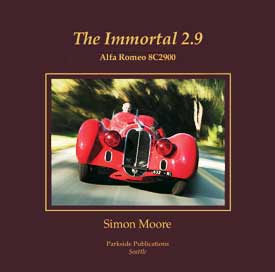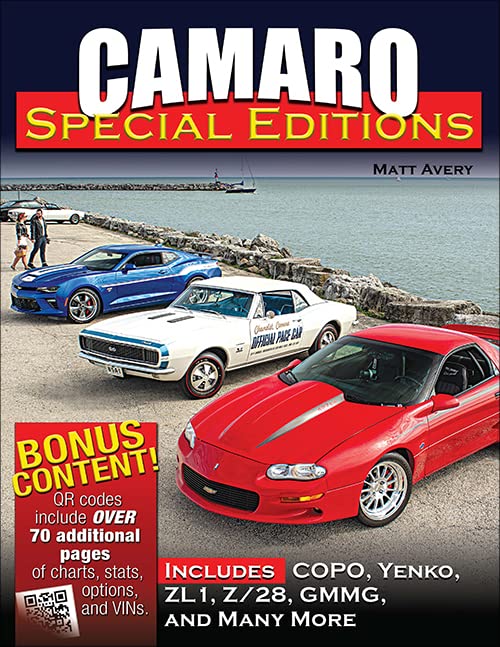
Discover a fascinating array of special edition Camaros written by Chevrolet historian and COPO authority, Matt Avery.
Chevrolet’s iconic Camaro arrived in the fall of 1966 and, although tardy to market, it came ready to mix things up in the wildly popular “pony car” segment. Ford’s Mustang was a runaway success, but this new competitor reined in momentum by offering customers an even closer friend of driving enthusiasts.
A credit to General Motors, the Camaro charged hard out of the gate, becoming an instant hit. In each of its first three years, it sold almost a quarter million units, causing a decline in sales for the crosstown Detroit rival. In the decades to follow,
Chevy crafted Camaro variants to suit everyone with enterprising hot rodders and performance tuners always taking it one step further. Enter the high-octane world of Camaro special editions.
Driven to achieve their own competition success and following the high-revving demands of enthusiasts, numerous Camaro special editions have been produced over the years, becoming some of the most collectible cars of all time.
Covered here are not only the factory models such as Indy 500 and Brickyard 400 pace and festival cars, ZL1s, anniversary editions, IROC-Zs, Player’s Challenge, Hot Wheels editions, Z/28s, and RS/SS cars. Also, Camaro Special Editions covers the legendary COPO cars and dealer go-fast specials from builders including Yenko, Dana, Nickey, Berger, Baldwin-Motion, Gorries, and Dick Harrell.
More modern performance editions are covered as well with Callaway, SLP, SVE, GMMG, Earnhardt, and more. Detailed information is provided on the most notable models from 1967 to today, including build numbers, production specs, and their collectability.
This book is a must-have resource for the Chevy and Camaro faithful.
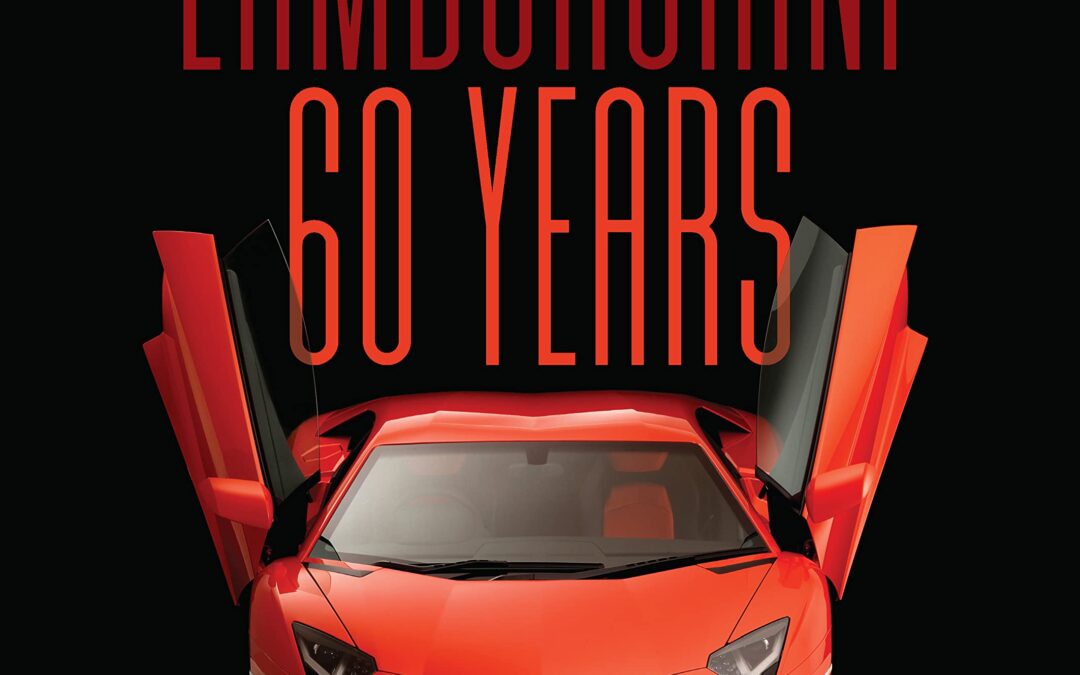
Celebrate six decades of outrageous, unforgettable Lamborghini cars with this must-have volume featuring fascinating history and stunning photography.
Sixty years ago, Ferruccio Lamborghini put the sports car world on notice with the introduction of his V-12-powered 350 GT. Just three years later, in 1966, Lamborghini stunned the automotive establishment with its introduction of the stunning Miura, the first mid-engine production car. Rivals at the 1966 Geneva Auto Show could only stare in wonder. Wrapped in a svelte Marcello Gandini–penned body and powered by a 350-horsepower V-12, the Miura instantly made every other sports car look antiquated, including those offered by Lamborghini’s Italian rival, Ferrari. It would be two years before Ferrari offered its own mid-engine reply in the form of the 206 Dino GT.
For Lamborghini, there was the time before the Miura and the time after the Miura. It marked a sea change not only for the Sant’Agata manufacturer but for the sports car world broadly. The Supercar had arrived.
In 1974, Lamborghini again shocked the automotive world with the mad Countach (an Italian expression one might utter at the sight of a beautiful woman), another Gandini masterpiece. Wide, low, and purposeful, the Countach completely redefined the supercar template, in the process becoming the poster car of choice for children of all ages the world over.
As Supercars evolved to Hypercars, Audi acquired Lamborghini, giving new life to the firm and unleashing a series of amazing cars from the Murcielago to the Gallardo to the Aventador and Huracan. Today, there is even the all-purpose Urus SUV!
In this richly detailed survey spanning 60 years of extreme performance, each of Lamborghini’s seminal cars is detailed and complemented by historic and commissioned photography and technical specifications. Captivating to read and beautiful to behold, Lamborghini Supercars: 60 Years belongs in every sports-car fan’s collection.

Stock-car racing star, country singer, and sports broadcaster Kyle Petty shares his familial legacy, intertwined with NASCAR’s founding and history, in Swerve or Die―written with Pulitzer Prize-winner Ellis Henican, the New York Times bestselling coauthor of In the Blink of an Eye.
“Born into racing royalty. The only son of NASCAR’s winningest driver ever. The grandson of one of the sport’s true pioneers. The nephew of our very first Hall of Fame engine builder. It’s quite a family to represent, and through it all, I’ve somehow managed to keep being Kyle.”
Kyle Petty won his very first stock-car race, the Daytona ARCA 200, in 1979 when he was eighteen. Hailed as a third-generation professional NASCAR racer, he became an instant celebrity in circles he had been around all his young life. Despite being the grandson and son of racing champions Lee Petty and Richard Petty, Kyle didn’t inherit innate talent. Working in his family’s North Carolina race shop from an early age, he learned all about car mechanics and maintenance long before he got behind the wheel. And although Kyle continued the family business, driving “Petty blue” colored cars emblazoned with his grandfather’s #42―a number once used by Marty Robbins―his career took a different route than his forebears’.
In Swerve or Die: Life at My Speed in the First Family of NASCAR Racing, Kyle chronicles his life on and off the racetrack, presenting his insider’s perspective of growing up throughout the sport’s popular rise in American culture. In between driving and running Petty Enterprises for thirty years, Kyle took some detours into country music, voiced Cal Weathers in Pixar’s Cars 3, and started his annual motorcycle Kyle Petty Charity Ride Across America. And when his nineteen-year-old son Adam, a fourth-generation racing Petty, tragically lost his life on the track, Kyle founded Victory Junction, a camp for children with chronic and serious medical conditions in Adam’s name―with help from Academy Award-winning actor and motorsports enthusiast Paul Newman.
Filled with NASCAR history, stories of his family’s careers, and anecdotes about some of stock-car racing’s most famous drivers, Kyle’s memoir also tackles the sport’s evolution, discussing how welcoming diverse racers, improving car and track safety features, and integrating green technology will benefit NASCAR’s competitors and fans in the future.
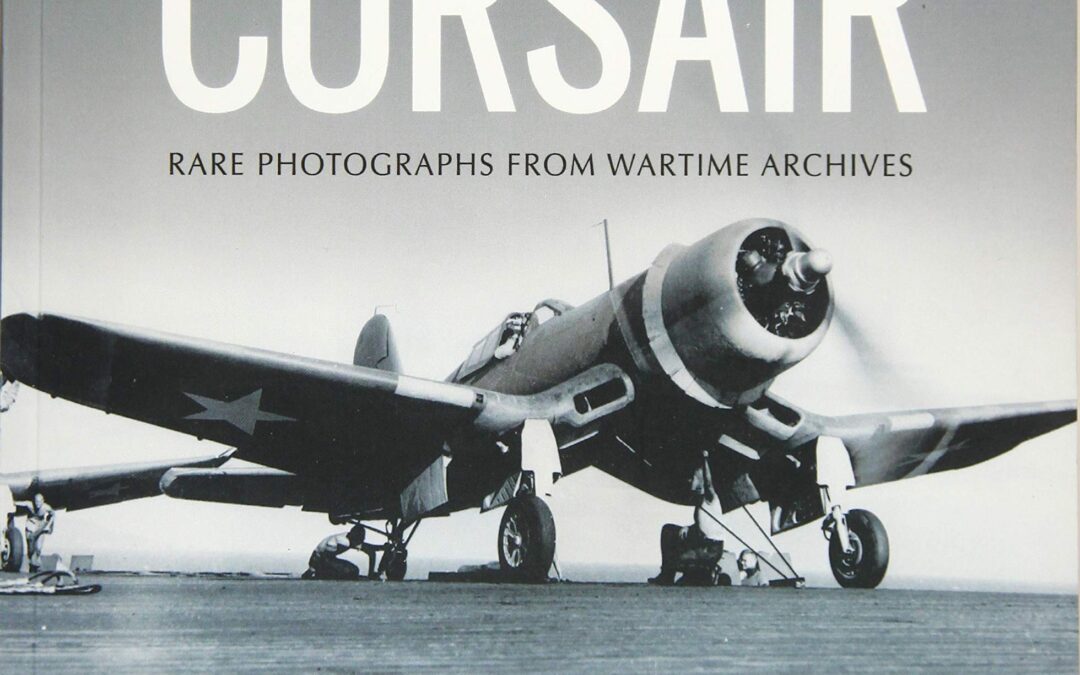
First flown in 1940, the prototype Vought F4U Corsair instantly became the fastest fighter in the world and the fastest US aircraft of any description. Powered by a huge 18-cylinder Pratt and Whitney Double Wasp engine driving an enormous 13 feet 4 inch propeller, the first Corsairs were capable of 417mph. This figure would rise to nearly 450mph in later versions.
Production began in 1941, not only by Vought but also by Goodyear and Brewster, and the F4U entered service with the US Navy in September 1942. The aircraft subsequently came to be extensively used from land and sea by the US Marines, Royal Navy and Royal New Zealand Air Force. Famous squadrons like VMF-214 ‘The Black Sheep’ and VF-17 ‘Jolly Rogers’, along with many others, maintained total ascendancy over the Japanese for the rest of the war – a remarkable achievement for a single type.
After the Second World War the Corsair remained in production and was used with distinction by the French in Indo-China and again by the US Navy in Korea. Since then Corsairs have achieved significant success in air races and more and more are being restored to fly for museums and warbird enthusiasts the world over.
This comprehensive new book combines technical information and detailed development history with a fascinating combat history told, in many cases, by the Second World War and Korean War pilots themselves. Well researched, readable and illustrated with scores of rare and previously unpublished photographs, The Vought F4U Corsair is the perfect book for any fan of the ‘bent wing bird’.

The Yamaha FS1-E is a 1970s icon. Introduced in the early ’70s, it became an instant success, giving 16-year-olds their first taste of motorcycle performance and freedom, and totally overshadowing the other mopeds available at that time.
Many riders had their FS1-E for one year only before progressing to larger machines. Today, nostalgia for the youthful exuberance engendered by the ‘Fizzie’ has resulted in many ex-owners wanting to recreate their pride and joy.
Most FS1E ‘s have not endured the test of time well, and very few good original examples exist. There are, however, plenty of restorable machines around, and this book guides the do-it-yourself restorer through the process, from the minefield of initially finding a machine to restore, to the potential pitfalls of a first restoration. The bikes featured and photographed for the book include a seriously neglected 1974 machine, a part restored 1976 model – of dubious type, and a 1975 DX model which arrived as a pile of bits.
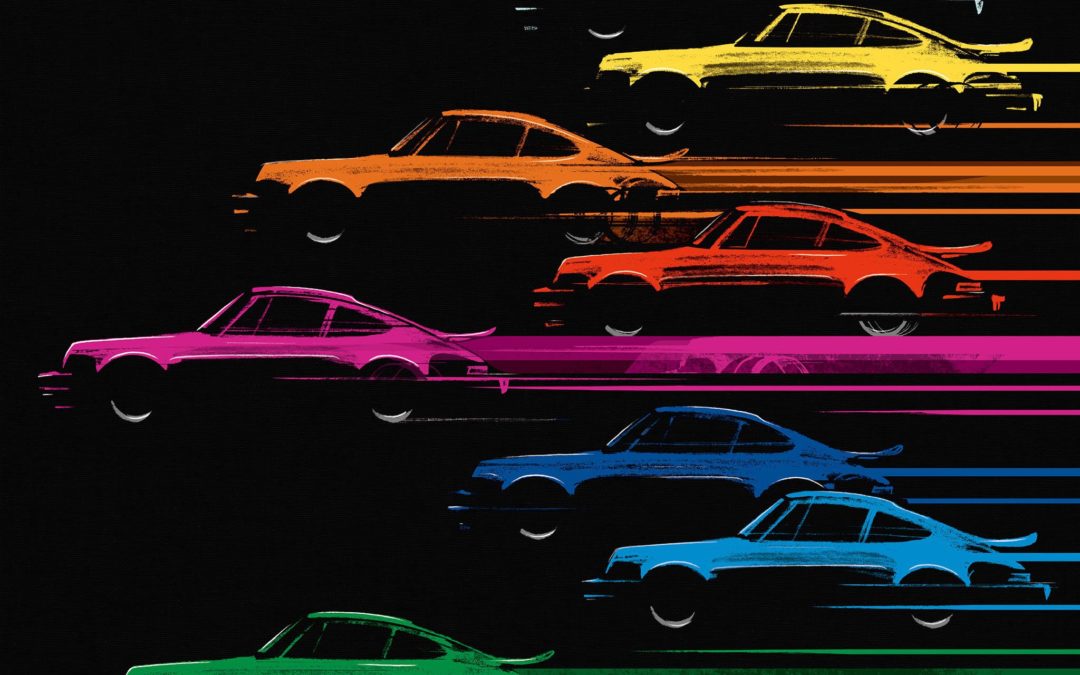
The mid-1970s were dark times for the automotive industry, and darker still for those passionate about high-performance cars. Manufacturers worldwide, struggling to comply with new emissions and safety regulations, were finding it difficult to produce cars capable of delivering a satisfying driving experience. With one or two exceptions-very expensive models built in minute quantities-none did. The cars produced in these years were at best compromised; most were simply dreadful. The OPEC oil embargo had just turned everything upside down while safety and emissions standards were strangling performance and stifling innovation from manufacturers. It was an atmosphere of complete and utter despair, as though all had been lost. Then-out of nowhere-Porsche dropped a bombshell, announcing a turbocharged series production supercar that not only met regulatory requirements but also delivered blistering performance. The 3.0-liter Turbo was an instant sensation, inspiring enthusiasts from every corner of the world and offered hope that perhaps there was still a future for performance cars.
The second Parabolica Press title, Turbo 3.0 continues the theme of being carefully researched using the Porsche archives, private collections, period documentation and intensive study. In an attempt to cover everything an owner, restorer or enthusiast would want to know about the dawn of Porsche’s turbocharged supercar, Turbo 3.0 includes a considerable amount of material never before published: comprehensive discussions of original options, close-up photos of key details, scenes from factory production, coverage of special one-off models and period motorsports. This is the definitive book about Porsche’s immortal 3.0-liter Turbo and it is essential reading for anyone who has ever owned, driven or simply lusted after the first supercar of the modern era.
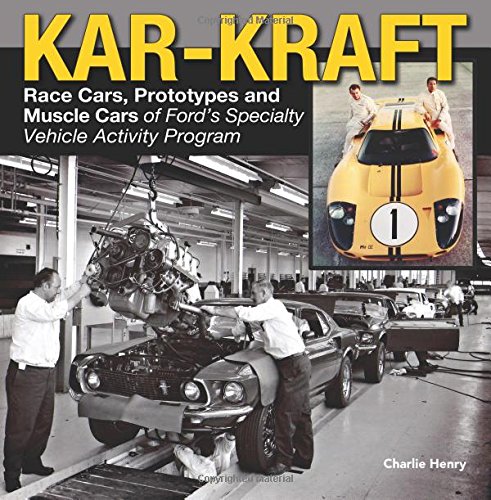
The story of Kar-Kraft began, as did many others in the automotive industry, with an axe to grind. In 1963, Ford was seriously interested in purchasing Ferrari. Ferrari was a legendary brand with considerable success in racing, and Ford saw the acquisition as a great way to be instantly successful in the racing arena. When Enzo Ferrari realized that Ford would not give him complete control of the racing program, he backed out of the deal late in the process. Ford had spent millions in vetting and audits, which then set in motion a vengeful response against Ferrari. The result was the unthinkable: Ford beat Ferrari at Le Mans.
Ford wanted to become competitive quickly, but it did not have the race history or resources in house. To remedy the situation, Ford searched the U.K. for an independent company to help accelerate its race car development. It first settled on Lola Cars and set up Ford Advanced Vehicles. Later, Ford brought its LeMans effort to the U.S. and the Kar-Kraft relationship was established. Although Kar-Kraft was technically an independent company, it really only had one customer: Ford Special Vehicles. Kar-Kraft’s story doesn’t begin and end with the GT 40 that took the win away from Ferrari at Le Mans. Ford expanded upon the program and organized an all-out assault on racing in general. Cars were prepared for Trans-Am, NASCAR, NHRA, and Can-Am competition. Street versions of the Boss 429 were assembled under its roof. And fabled prototypes including the LID Mustang, Boss 302 Maverick, and Mach 2C were all assembled in Ford’s contracted race shop. And then, out of the blue, its doors closed for good on a cold day in 1970.
History tells us that Ford won Le Mans, the Daytona 500, and the Trans-Am championship. But it doesn’t tell us how this was accomplished. Author Charlie Henry (a former Kar-Kraft employee) has enlisted the help of many of his former co-workers to bring you the very first book ever published on Ford’s all-encompassing special projects facility, Kar-Kraft.

SOLD OUT
The legendary 1967 Camaro was Chevy’s answer to Ford’s Mustang, and they’ve been duking it out ever since.
The early 1960s saw American auto manufacturers desperately trying to sell cars to the emerging baby-boom market. Chevrolet attained some success with its sporty Corvair Monza. Ford responded first with a sportier Falcon, then with its grand-slam, home-run pony car, the Mustang. At first, Chevrolet hesitated to abandon the technologically advanced Corvair, but when it finally entered the pony car market in 1967, its new Camaro instantly became one of the most iconic cars of the classic muscle-car era, a serious competitor for the Mustang. Since then, some of the most important performance cars in American history have been Camaro models: RS, SS, Z28, and IROC-Z.
When muscle cars went dormant for a generation, it was once again the classic pony cars that jump-started American performance. The battle that raged between Camaro and Mustang in the 1980s rejuvenated the US auto industry’s interest in high-performance muscle cars.
The Camaro lost its way in the 1990s, with Chevrolet pursuing technological advances and Ford pursuing classic American muscle. As was the case in the 1960s, Ford’s muscular pony car trounced Chevrolet’s technologically advanced sporty car in the race that mattered most: showroom sales. The Mustang thrived while the Camaro left the scene. Fortunately, that departure was only temporary. Chevrolet introduced a twenty-first-century Camaro in 2010, and it has become one of Chevrolet’s most popular models.
With stunning photography from author Mike Mueller and never-before-seen archival photography from partner General Motors, Camaro: Fifty Years of Chevy Performance chronicles the Camaro’s rich history, from the early attempts to reach the youth market in the 1960s, through the potent and turbulent years of the classic muscle-car era, the resurgence of muscle in the 1980s, the sad decline of the 1990s, and the triumphant rebirth of the new car in this new millennium.
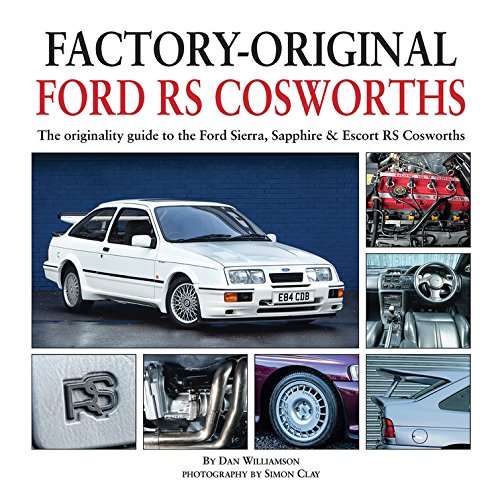
The originality guide to the Ford Sierra, Sapphire & Escort RS Cosworths
When Ford teamed up with Cosworth Engineering to breathe life onto its humdrum Sierra, few knew it would be the birth of a motoring legend. Through circuit racing and supercar-humbling on-road ability, the 1985 Sierra RS Cosworth quickly became a household name.
A practical four-seater boasting 204bhp from its two-liter turbocharged power plant, the RS Cosworth’s massive performance was equaled only by an extroverted rear wing designed for high-speed stability
.
While motorsport machines scooped innumerable victories and increasingly powerful engines, in 1987 Ford homologated a yet-more-spectacular Sierra – the 224bhp RS500. It instantly became a desirable collector’s piece.
The restrained four-door Sierra Sapphire RS Cosworth of 1988 was Ford’s vision of a 150mph executive express; two years later, its four-wheel-drive successor returned the firm to rallying. By 1992, Ford had squeezed the 4×4’s running gear into a shorter Escort body, complete with 227bhp engine and ever-more-aggressive aerodynamic aids.
The limited-edition Monte Carlo came in 1994, followed by the final RS Cosworth – a revised Escort with smaller turbocharger and user-friendly appeal. Production ceased in 1996. Today, each model has a loyal following among motorsport fans and fast Fords enthusiasts. And as the cars become increasingly sought-after, so too does the pursuit of perfection.
This book examines RS Cosworth authenticity, outlining standard specifications alongside in-depth color photography of outstanding examples of the breed. From body panels and trim to turbochargers and tires; from interior fabrics and paint schemes to shock absorbers and stickers, Ford’s factory-original fitments are covered in comprehensive detail.

In 1997 Chevrolet did the unthinkable: they re-designed the most popular and most modified engine in American history.
The Chevrolet small-block V-8 made its debut in 1955, and with its arrival, Chevrolet instantly leaped to the forefront in the minds of hot rodders and performance enthusiasts alike. While the engine grew in displacement and technology over the next 30 years, its basic design remained unchanged . . . until 1997, when the Generation III LS1/LS6 engine design was introduced. The LS1 engine first appeared in the 1997 Corvette, and soon followed in the Camaro Firebird and thousands of full-size Chevy trucks and SUVs. It also powers the hot new Pontiac GTO!
This book is essential for the enthusiast who wants to get the most performance out of this new engine design but is only familiar with the older Chevy small-blocks. Covered is everything you need to know about these engines, including the difficult engine removal and installation, simple engine bolt-ons, electronic controls for the Generation III engine, and detailed engine builds at four different power levels.

The Pan American clipper ships of the 1930s and 1940s were technological marvels of their time. The years before World War II found the United States faced with international challenges of an economic as well as a military nature. Aided by government regulations and contracts, the Pan Am clippers were, for a time, the only international craft to carry the U.S. flag. Commercially, they rivaled the comfort and popularity of passenger trains and luxurious cruise ships. Militarily, they were unmatched by anything the Germans, Russians, Italians or French could produce. The only long-range aircraft capable of carrying transoceanic payloads, clippers became instantly valuable with the onset of the war. Marketed as the ultimate in commercial–or military–airfare, these flying boats became as much an American icon as the Pan Am logo itself. From the movie screen to the bookshelf, this volume examines the multitude of ways in which the values inherent in Pan American Airways’ clipper ships played out in popular culture. The book discusses the strategies Pan Am used to represent the clipper as a paragon of U.S. interests, values and beliefs. Mirroring the moods of the times, the clipper became a consistent American icon, being associated with the Statue of Liberty and the American eagle. The main focus of the work is the variety of ways in which this iconographic status manifested itself through toys, movies, pulp fiction, comic books and music. Clipper influence is also examined in other unlikely places such as the name of an available car color, car models, restaurant menus and lounge names. An appendix explains different models of the clipper flying boats.
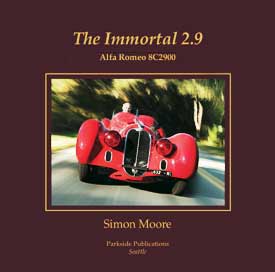
The Revised Edition of The Immortal 2.9 is finally here! A new edition of this classic motoring book has been anxiously awaited by automotive enthusiasts for many years. First published in 1986, the original edition became an instant classic and established Simon Moore as the world’s foremost authority on the history of Alfa Romeo’s famous pre-war eight-cylinder cars.
Only 2,500 copies of the first edition were printed and the book has not been available for twenty years. It became a true collectors’ item and copies have recently been trading for more than $1,000.
The Immortal 2.9 was hailed as a milestone of automotive literature because it broke new ground by relating the history of individual automobiles and their owners. The Society of Automotive Historians awarded the book its Nicholas-Joseph Cugnot Award as the best automotive book of 1986. The book frequently appears on commentators’ lists of the best automotive books ever published.
Simon’s research into the history of the 2.9 cars did not stop upon publication of the first edition. His detective work has continued unabated and the history of these fabled cars continues to unfold. Cars thought to have been lost forever have resurfaced; more of the cars were restored and reappeared in public; some of the historical assumptions in the first edition proved to be inaccurate or incomplete; gaps in the historical record of many cars were filled; and hundreds of “new” historic photos were found. Perhaps most important, the stature of the Alfa Romeo 8C2900 as an icon in the history of the automobile has continued to grow.
Collectors Edition HERE

The Series II [1958-61] and Series IIA [1961-71] Land Rovers defined the iconic shape of the vehicle which is still instantly recognizable in today’s utility models from Land Rover. Compiled over nearly thirty years, with the aid of reference material produced by Land Rover and many dedicated enthusiasts, this comprehensive guide to the specifications of the Series II and IIA vehicles looks not only at Land Rovers as they were when they left the assembly lines but also at dozens of options and ‘approved’ special conversions – and some which did not receive factory approval, too.
Autobooks-Aerobooks 2900 W. Magnolia Blvd. Burbank, CA 91505 (818) 845-0707 Hours: Tuesday-Friday 10:00 AM – 6:00 PM Saturday 10:00 AM – 6:00 PM Closed Sunday and Monday Accept Credit Cards gift cardYES, We have Gift Cards - Click Here AUTOBOOKS IS OPEN...
